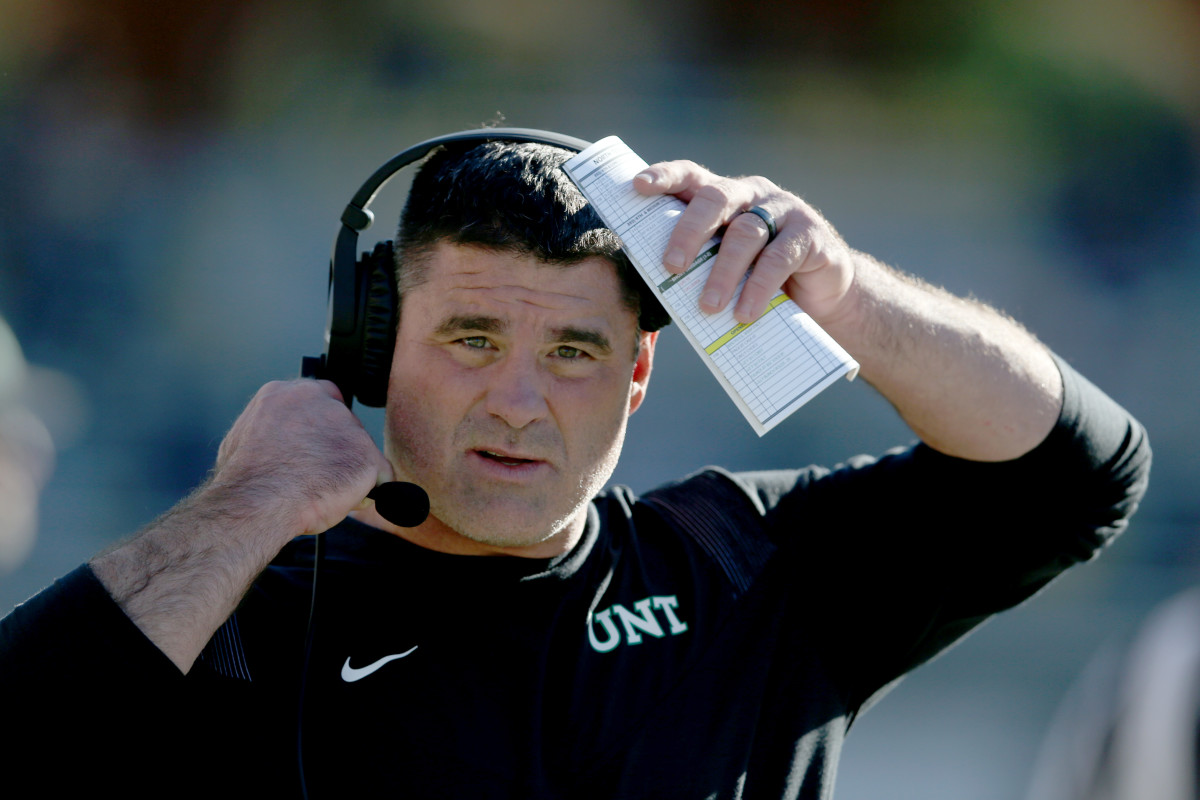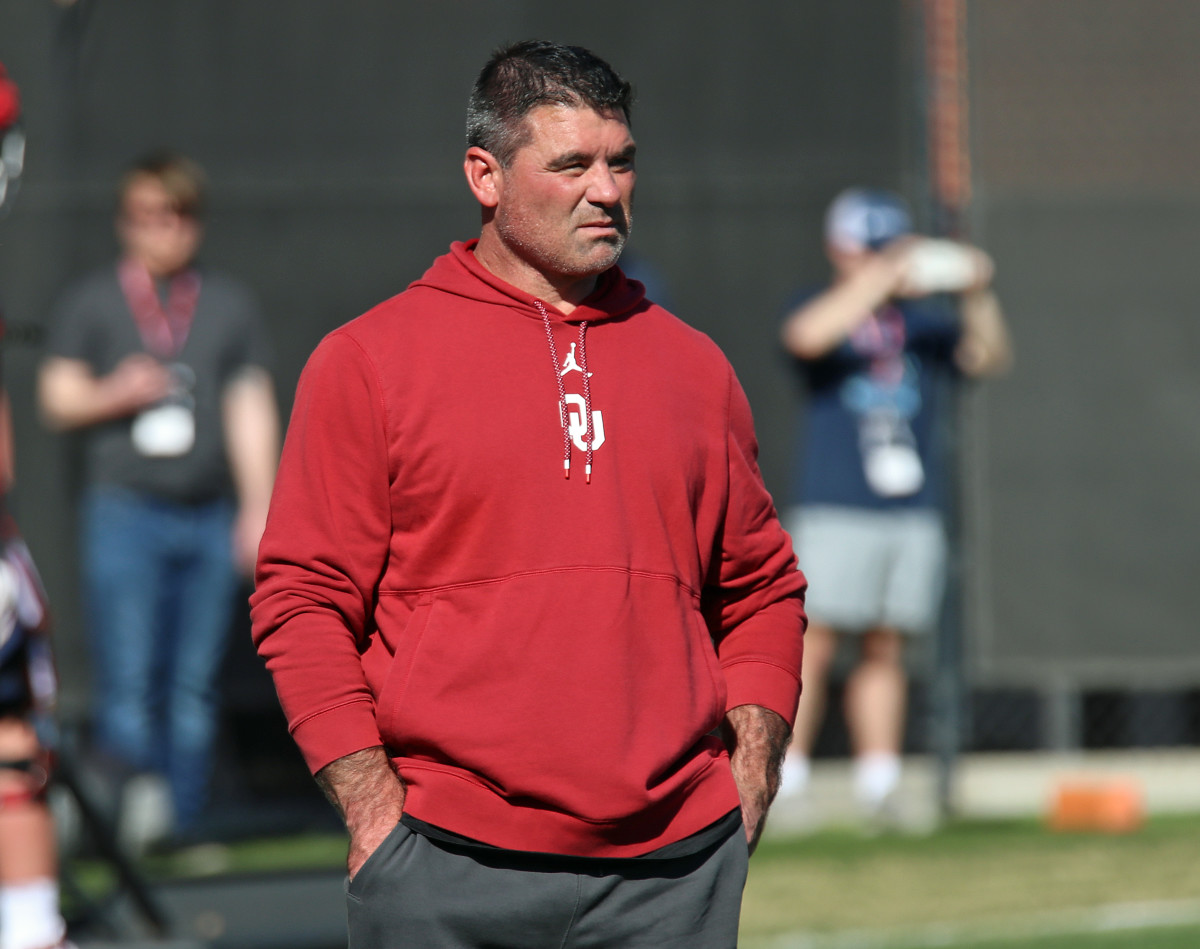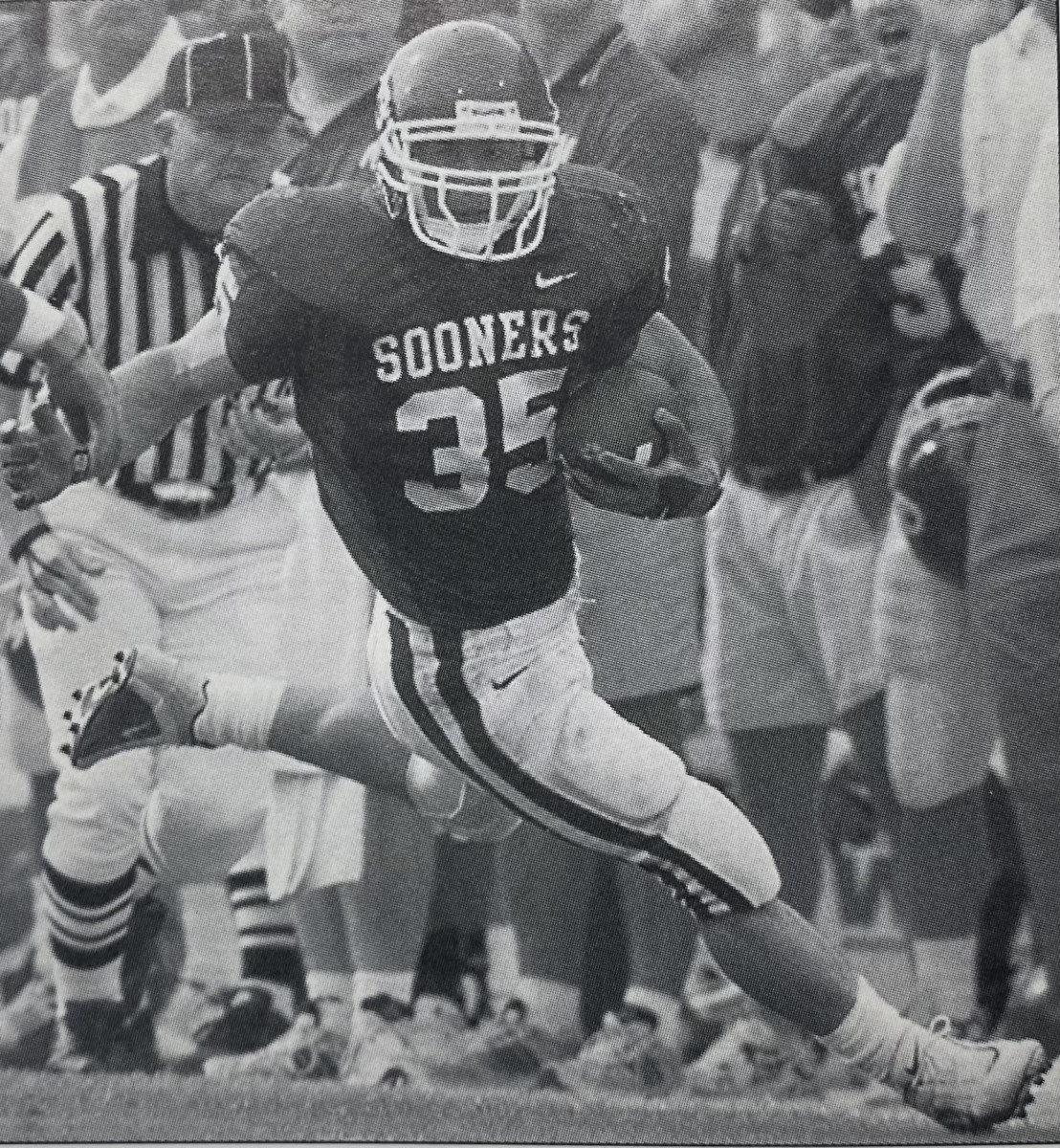What Oklahoma is Getting in New Offensive Coordinator Seth Littrell

Like so many fingerprints, the influence of college football offensive innovators like Mike Leach, Mark Mangino, Kevin Wilson and Larry Fedora are all over Seth Littrell.
Oklahoma’s new offensive coordinator — Littrell will call plays and coach quarterbacks, the school announced Wednesday, promoted from offensive analyst along with tight ends coach Joe Jon Finley to co-coordinator — has studied under some of the best to ever do it on his way to sitting in the head coach’s seat for seven years at North Texas.
“This has been a dream of mine since I was a child,” Littrell said in a press release. “I left OU after the 2000 season and it’s taken me 23 years to get back here. There’s no better honor.”
Just like he did when he was hired at North Texas eight years ago, Littrell gave credit to those men for whom he has worked.
“Obviously I learned a ton from my time with Mike Leach, Kevin Wilson, Larry Fedora and others,” he said. “I’ve been around a lot of amazing coaches and amazing people.”
Venables Names Littrell Offensive Coordinator, Finley Co-Coordinator
Still, amidst his diverse background and clever offensive schemes, one word sums up the Sooners’ new play caller better than any coaching tree.
Toughness.
“When he walks in the door,” said former teammate Jason Freeman, “toughness is coming with him.”
Starting with Oklahoma’s bowl game this year and certainly carrying over into OU’s first season in the SEC in 2024, Littrell’s offense will look a lot like those under whom he has studied.
“You nailed it,” said Mason Fine, Littrell’s quarterback at North Texas. “With all the coaches he’s been under, he’s kind of mixed and matched a lot of offensive schemes that he’s liked throughout his years that he’s used for his offense.”
But whatever system Littrell installs, Sooner Nation can count on OU offensive players being tough.
“That’s one thing he’s gonna demand from everybody across the field if you’re on offense,” Freeman told AllSooners. “You’re gonna be tough. And if you’re not, you’re probably gonna have a hard time getting on the field for him.”
“No matter what,” Fine said, “he’s a smart guy, he’s a football mind, he’ll know what to use and what not to use.”
OU coach Brent Venables described the hire in Wednesday’s press release as “an easy and convenient move, but it was also the best move for our program, our players and our staff.”
Venables said he was glad to be able to promote a couple of former Sooners. Finley played tight end at OU from 2004-07.
After he finished his playing days as Bob Stoops’ first great concrete fullback at OU, Littrell was a graduate assistant for two years at Kansas under Mangino. He was Leach’s running backs coach for four years at Texas Tech, then joined Mike Stoops’ staff at Arizona.
That’s where Littrell’s football mind took off and his coaching star began to rise.
Littrell coordinated offenses at Arizona (2011) under Stoops, Indiana (2012-13) under Wilson and North Carolina (2014-15) under Fedora before his seven-year stint at North Texas.
The Mean Green was a lifeless program when Littrell arrived, with just one bowl trip over the last 11 seasons. But Littrell took them to six bowl games in seven years, twice won nine games and twice played for the Conference USA Championship. Fine was the two-time C-USA Offensive Player of the Year and today is a starting quarterback in the Canadian Football League.
“He’s got a lot of years of experience, he’s had a lot of different influences, and I know he’s kind of put together this offense that can be No. 1 in the nation, for sure,” Fine told AllSooners.
As head coach in Denton, Littrell hired a couple of gifted offensive coordinators — former Tech quarterback Graham Harrell and former Houston offensive lineman Mike Bloesch — and delegated the play calling.
But in five years as an offensive coordinator, Littrell’s offenses were aggressive and flexible — and always experienced an immediate surge:
- From 28.2 points per game in 2010 in Tucson to 30.8 in 2011.
- From 21.4 points per game in 2011 in Bloomington to 30.8 in 2012 and 38.4 in 2013, which ranked 16th in the nation.
- And from 32.7 points per game in 2014 in Chapel Hill to 33.2 in 2014 and 40.7 in 2015, which ranked No. 9 in the nation.
He’ll have trouble replicating that kind of turnaround. Under Jeff Lebby, OU had a top-five offense in numerous categories this season.
But Littrell’s emphasis on an efficient but big-play passing game and a power running game — all out of familiar spread formations, but also heavy with tight ends and running backs — have more than just a feel of his frequently flashy coaching mentors. He’s taken pieces and parts from each of them and incorporated those into his own personality that’s built on toughness, grit, and absolutely no bull.
“He’ll play to his players’ strengths,” Fine said, “and he’ll watch a lot of film and put a lot of great players in good matchups. So I’m excited to see it.”
Fine said the offense he played in as a four-year starter at UNT — he’s the school’s career passing leader with 12,505 yards, 93 touchdown passes (100 total), a 140.68 efficiency rating, attempts (1,655), completions (1,039) and more — evolved during his time in Denton and continued to evolve after he left.
The Oklahoma offense will at times look like Wilson’s spread-option at Northwestern and Indiana, but more frequently will resemble some of Lebby’s Baylor schemes — spreading receivers out to the boundaries, playing fast and throwing deep. Littrell’s route tree from the inside receivers, H-backs and tight ends will remind people of Leach’s spread at Texas Tech, but his multiple run concepts will bring to mind what Mangino did at OU and Kansas. And of course, Littrell will often incorporate Fedora’s hyper tempo to find mismatches and wear down defenses.
Fine said to expect the Sooners to run a lot of different personnel packages — one-back/no tight end, one back/one tight end, one back/two tight ends, two backs/no tight ends and more — in an effort to bully people.
“A lot of tight end usage, a lot of double backs,” Fine said. “And then he also spreads the field with the air raid concepts.”

“Not that coach Lebby didn’t have an emphasis on the run game, because I do think he did at times,” Freeman said, “but I think the run will probably look a little different with him. He’ll do it out of different packages. How much tight end will be used, I don’t know. I do think his run game out of four-wide is pretty complex. And there’s a possibility you could see that, especially with a kid like Jackson (Arnold) — get a light box and having two guys who can run the football is gonna be extremely difficult (to defend). I think that’s something he specializes in, is spreading guys out and being able to run the football.”
Under Harrell, North Texas used a lot of Leach’s air raid for underneath passes with endless option routes. But under Bloesch, Fine was often reading the opposing safeties and counting bodies in the box. Littrell will probably do both.
“Just kind of easy reads for the quarterback,” Fine said, “and not a whole lot of guessing.”
As for running the football, Fine said the Mean Green utilized both gap blocking and zone blocking schemes to great effect.
“We had a lot of great run schemes that would always open up holes when I was there,” Fine said. “He had a great run game. When I was watching film, our run game had a little bit better schemes than a lot of other teams — especially later into my college career with tight ends or stuff like that. So a lot of different run schemes.”
Fine set Oklahoma’s all-time career record with 13,081 passing yards and 166 touchdown passes — both in the top 10 nationally in high school football history — but got only one FBS scholarship offer out of Locust Grove High School: North Texas.
He and Littrell were perfect for each other — the right coach and the right quarterback at just the right time.
The 5-foot-11, 190-pound Fine also ran the football in high school, and was called on to do it frequently at UNT: 325 rushing attempts in four seasons. So expect OU quarterbacks — Jackson Arnold at first, Michael Hawkins in the future — to run the football.
Fine said he ran a lot of quarterback draws, counters and traps, patiently waiting for pulling guard to open things up or lead him through a hole. He also ran read-option keepers. Off of those, he would motion a back out of the backfield and read the safety’s reaction, then decide to either keep it into a light box or throw it deep if the safety went with the back in man coverage.

Fine reiterated that if the quarterback is good at running the football, Littrell will let him run the football. In his two-plus seasons at North Texas, current Kansas quarterback Jason Bean averaged 6.2 yards per carry as a redshirt freshman in 2019 and 6.2 yards per carry as a third-year sophomore in 2020 — 426 total yards on the ground with five touchdowns.
“I think he definitely wants to use the quarterback to run it,” Fine said. “But if your quarterback is more of a pocket passer, he probably won’t do that.
“Any type of run scheme, he’s at the top of the minds in the college game right now. And in the passing game, I think he’s proven that he’s been able to kind of become a little better in that through all his years of experience.”
Fine said Littrell will also turn up the tempo — when the time is right.
“It was a weapon, for sure,” Fine said. “He liked to change tempos. At times, ‘Hey, we’re gonna huddle up because that’s what we want to do, let’s go slow and see what the defense is doing.’ And at times, ‘Hey, we want to get in tempo and go fast because we need to get momentum going or maybe we need a spark or our offense has kind of been slacking.’ Or, ‘Hey, we got ‘em on their heels, now let’s hit ‘em with tempo, go fast-fast-fast, then boom, we’ll slow it back down and maybe draw a double cadence and get them offsides.’ “
Littrell also may have picked up a few more Baylor tendencies from Bloesch, who coached at Tulsa under former Art Briles disciple Philip Montgomery.
“When I left and we watched North Texas a little bit,” Fine said, “he ran a lot of the Briles-type of offense when it came to the passing game, which is really explosive, spread the field, use up as much splits as you possibly can from the receivers and take shots and be aggressive when the time comes. Maybe a little bit lower completion percentage, but the yards per attempt and explosiveness was just through the roof.”
Littrell brings more than just square-jawed toughness and offensive versatility to the Sooner staff room. When Brent Venables brought him back as an offensive analyst last March, he also brought a certain strand of OU DNA that will serve the program well once more.
As a coveted recruit at Muskogee High School — one of Oklahoma’s toughest towns — he rushed for 3,603 yards and 52 touchdowns as a fullback and earned All-State accolades as a linebacker. As a senior, Littrell was second in Oklahoma’s Class 6A with 1,385 rushing yards and scored 29 TDs.

You want tough? How about two state wrestling championships — one at 189 pounds as a junior and one at 215 pounds as a senior?
“That doesn’t happen very often,” Freeman said.
As the son of two-time national champion fullback Jim Littrell, who played for Barry Switzer in the mid-1970s, Seth went to Oklahoma dreaming big dreams. But those dreams hit some early speed bumps.
In 1997, Littrell was one of just two OU freshmen to start for John Blake’s Sooners, drawing the starting assignment against Nebraska and OSU. Against the Cornhuskers, he rushed 21 times for 88 yards and scored his first touchdown as a Sooner. In the ’97 season finale, he rushed 17 times for 81 yards and two TDs against Texas Tech. But the Sooners finished the season 4-8.
In 1998, Littrell became a regular starter and finished second on the team (behind De’Mond Parker) with 205 rushing yards. But OU went 5-6.
In 1999, his first season under Bob Stoops and learning an entirely new scheme under Leach, Littrell rushed for 231 yards and led the team with seven rushing touchdowns. Stoops resurrected OU to a 7-5 record.
But in 2000, everything came together in OU’s magical, 13-0, national championship season. Littrell’s offensive role diminished somewhat as Mangino took over for Leach and had more weapons at his disposal. Littrell ran just 22 times for 70 yards and caught 10 passes for 109 yards with two total touchdowns. But being a forceful leader and permanent captain on OU’s first-ever 13-win team was more fulfilling for Littrell than smashing into the end zone.
For a good peek into Littrell’s makeup and football instincts, look no further than his contributions on special teams as a player. Although he was a captain on the 2000 squad and finished his career with 707 rushing yards and 14 total TDs, Littrell was a special teams demon all four years, earning OU Special Teams Player of the Year in 1999, causing and recovering a fumble in the ’99 Texas A&M game, recovering a blocked punt in the end zone in the ’98 Baylor game and collecting 14 special teams tackles during his junior season.
Littrell becoming a big-time coach always seemed inevitable. From his famous father to his fullback days to his many influences along the way, football has always been in his blood. He played in high school for Oklahoma coaching legend Ron Freeman, whose son Jason was an OU tight end and Littrell’s teammate both at Muskogee High and at OU in 1997-98 — and whose grandson, Gavin Freeman, plays for the Sooners now.
“I don’t group a whole lot of people in this category,” Jason Freeman said, “but in my eyes, him, Kelly Gregg and Chris Hammons, those are the three that if I got caught in alley somewhere I would hope would be on my side.
“That’s the first thing with him is toughness. Fierce competitor.”
Littrell lives the game, eats, breathes and sleeps football. In less than a year with Lebby, Fine said he’s probably already added much to his coaching encyclopedia, and will put it all to use as the Sooners’ offensive coordinator.
“He kind of molds and adapts from year to year,” Fine said. “He uses his players’ strengths really well — ‘What offense is best for my players?’ Not necessarily ‘Hey, this is my scheme, this is how I’m gonna do things, this is how I’m gonna run it.’ I think he really adapts well to his players and their talents and really hides a lot of weaknesses, wherever that may be on a team.”
“He’s a great football mind. He’s a great leader. I think he’s gonna do a wonderful job with the talent and resources he has in Norman.”
- Follow AllSooners on Twitter to stay up to date on all the latest OU news!
- Want even more Sooners news? Check out the SI.com OU team page here!
- Listen and subscribe to the AllSooners Podcast!
- Listen and subscribe to the AllSooners Podcast!
- Watch more Sooners videos and subscribe on YouTube!
- Sign up for your premium membership to AllSooners.com today, and get access to the entire Fan Nation premium network!
